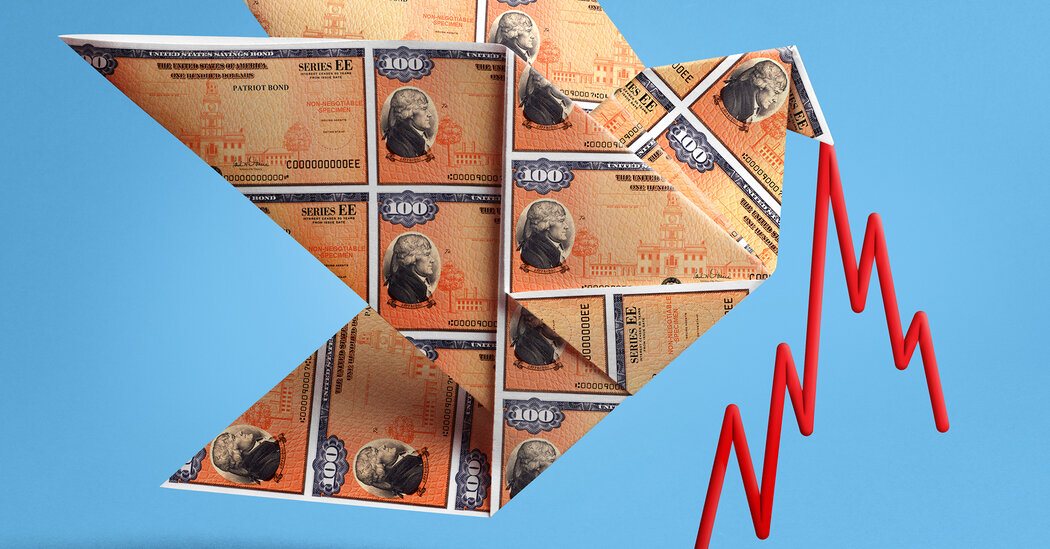
Bonds May Be Having Their Worst Year Yet
It is a horrible time for stocks, which have spent the year in a bear market. But guess what? When you look at the historical record, bonds are worse.
This year is the most devastating period for bonds since at least 1926, the numbers show. And, in the estimation of one bond maven, 2022 is shaping up to be the worst year for bonds since reliable record-keeping began in the late 18th century.
Yet as bad as things are now, history and basic fixed-income math tell us that bond investors will begin to experience relief when interest rates stop rising. You can count on that eventually, though we don’t know when it will happen.
Much as truly long-term investors are likely to be better off if they can ignore the turmoil in the stock market and just hang onto well-diversified holdings in low-cost index funds, most bond investors can expect to benefit if they can ride out this upheaval and hold onto their bonds, whether owned individually or in diversified funds.
More Lessons From the Volcker Era
Since the 1920s, the stock market has usually produced wonderful returns over the long haul, but it has frequently generated short-term losses that have dominated headlines. That’s certainly happening this year.
Bonds — especially the investment-grade core of the market, which includes U.S. Treasuries and high-quality corporate bonds — are supposed to be Steady Eddies, so boring that they are comforting. They provide an income stream and, typically, also offer something else: a buffer against losses in the stock market.
Not so this year.
Bonds are being hammered all over the world. British government bonds, known as gilt, have taken huge losses this week, and the Bank of England intervened.
In the United States, bond investors are experiencing large paper losses that are closely connected to red-hot inflation, and to the rising interest rates engineered by the Federal Reserve to curb the pace of soaring prices.
Because bond prices and interest rates (a.k.a. yields) move in opposite directions — that is simply the way bonds work — the steep rise in rates has automatically led to deep drops in bond prices.
It’s happened before.
The last time the Federal Reserve had to cope with inflation this high was in the early years of Paul A. Volcker’s tenure as Fed chairman, from August 1979 through 1982. He responded by sharply increasing interest rates and throwing the economy into two recessions.
Our Coverage of the Investment World
The decline of the stock and bond markets this year has been painful, and it remains difficult to predict what is in store for the future.
- Discordant Views: Some investors just don’t see how the Federal Reserve can lower inflation without risking high unemployment. The Fed appears more optimistic.
- Weathering the Storm: The rout in the stock and bond markets has been especially rough on people paying for college, retirement or a new home. Here is some advice.
- College Savings: As the stock and bond markets wobble, 529 plans are taking a tumble. What’s a family to do? There’s no one-size-fits-all answer, but you have options.
- Enduring Meme Stocks: The frenzy that saw traders congregate on social media and push stock prices for companies like GameStop higher can no longer be explained as simply a pandemic phenomenon.
I’ve examined that period in two recent columns, and it is especially illuminating for bonds.
Recall that after tightening rates for several years, Mr. Volckerdecided in the summer and fall of 1982 that it was time to relieve the economic pain. That was a turning point. Interest rates fell and the stock market rallied. For bonds, according to several measures, it was the best year of the last century.
I’m not predicting another spectacular turnaround for bonds right now, or even in 2023, only noting that amid all the gloom, it’s already possible to discern signs of a future turnaround. The economy is weakening, the Fed will pivot eventually — and bonds will rally.
Some bond bulls, like David Rosenberg, chief economist of his own firm, Rosenberg Research, go much further. He has been anticipating a recession for many months and points out that in such periods, as the economy shrinks, people tend to seek safety in Treasury bonds. That popularity of Treasuries, along with declining yields, typically increases bond prices.
“I’m confident that long Treasury bonds will be the best asset class over the next year,” Mr. Rosenberg said in an interview.
Still Safe
Before looking at the ugly numbers, try to stay calm. You don’t need to worry about high-quality bonds if you hold onto them. Treasury bonds, in particular, are still the safest investments you can get, in the sense that if you keep them to maturity, you won’t lose any money.
Try to sell them, though, and losses will kick in. And because mutual funds and exchange-traded funds must report the market values of their holdings, if you are a shareholder in such funds you are likely to have losses now, even if you haven’t sold any shares. Your diversified funds containing stocks and bonds have probably declined sharply in value, as well, because bonds haven’t provided their customary buffer.
Bonds produce income, but because interest rates were close to zero when the current surge in rates started, those increases in yield caused vertiginous drops in bond values, and there has been almost no income cushion to soften the blow.
A fancier way of putting this is to say that when bond yields dropped close to zero during the coronavirus recession of 2020, their prices became far more sensitive to the interest rate increases that arrived this year.
“We’ve had rates rise sharply before,” Edward McQuarrie, an emeritus professor of business at Santa Clara University, said in an interview. “But what made this year special was that rates rose from such a low level. That’s why bond returns this year have been so negative.”
Those Terrible Numbers
Even in a remarkably poor year for bonds, broad stock returns this year are worse.
The S&P 500, the most widely followed proxy for the U.S. stock market, has returned a negative 21 percent, including dividends, this year through Wednesday, according to FactSet. In the same period, the Bloomberg Aggregate Bond Index, the most widely used benchmark for the broad, diversified investment-grade U.S. bond market, has returned a negative 14 percent.
Compared with the stock market, the bond market may still look rather tame. But it’s truly awful right now, when you consider the history of the last century.
Vanguard posts handy benchmarks for broad stock and bond returns on its website that go back all the way to 1926. It has found that the worst calendar year for bonds in that period was 1969, with a return of negative 8.1 percent. That means that if 2022 were to end today, it would be much nastier for bond investors than what has until now been the worst year in nearly a century.
In fact, this year’s misery looks extraordinary on a much longer historical scale. Professor McQuarrie has compiled U.S. bond returns going all the way back to 1794. “You can safely say that through Tuesday,” he said, “U.S. bond returns are the worst ever recorded.”
A Little Perspective
I’d be remiss if I didn’t point out that whole sections of the bond market have done even worse than these statistics suggest.
Long bonds — those with many years to run, like 30-year Treasuries — are more sensitive to interest rate changes than one-year Treasury bills.That’s why, in this rising interest rate environment, the Bloomberg US Credit Long AA index lost 28.5 percent through Wednesday.
High-yield bonds, or junk bonds, have special problems. As the economy weakens, the risk of default rises and, in some respects, they trade more like stocks than Treasuries. Junk bonds are having a terrible year, too.
Stocks are in a bear market — defined as a decline of more than 20 percent from a previous peak — but that happens relatively often compared with bonds. Including this one, there have been 15 bear markets for the S&P 500 since 1926, according to Howard Silverblatt, senior index analyst for S&P Dow Jones Indices.
There has never been a decline that big for diversified investment-grade bond portfolios.
Most of the time, losses in these bonds are small. For example, the Schwab Center for Financial Research has found that since 1976, diversified, investment-grade bonds like these suffered calendar year losses only four times before 2022 — and they wereinconsequential, less than 5 percent in a given year.
What May Lie Ahead
“It’s likely that most of the damage in the bond market has already been done,” said Kathy A. Jones, chief fixed income strategist for the Schwab Center for Financial Research. Interest rates have already risen so rapidly that the average yield for the kinds of high-quality bonds in the Bloomberg Aggregate index is almost 5 percent.
“That’s becoming an attractive income stream,” she said. “There’s some good news in there for bond investors.”
The damage done to the economy from higher interest rates is probably just beginning, however. Mortgage rates have leaped well above 6 percent, and there are indications that the housing market is beginning to stumble. With interest rates rising, a lingering pandemic, supply chain glitches, an energy shock and the endless misery of Russia’s war on Ukraine, it would hardly be a surprise if the U.S. economy fell into a recession.
At some point, the textbooks tell us, as unemployment rises and the economy weakens, inflation will come under control. By then, as in 1982, the Fed will decide that it needs to relieve the economy. Traders in the bond market will rejoice and bond rates will start to drop.
Recall that because of the Fed pivot, 1982 was the best year for bonds in recent decades. The economy was in recession then, people were suffering, and the Fed responded. Both the bond and the stock market embarked on a prosperous road that lasted, with some severe interruptions, almost four decades.
I’m not counting on anything quite that momentous. While much of the damage in the bond market is probably behind us, the economy is slowing and the consequences for millions of people are still unfolding. So try to make sure you have enough cash to get through further disruptions.
But don’t despair. I expect that at some point in the not-too-distant future, the havoc of the last year will start to reverse. People with long horizons are likely to prosper.




